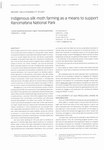|
|
|
|
First Page
![Indigenous Silk Moth Farming as a Means to Support Ranomafana National Park: [Report on a Feasibility Study]](http://www.madagascar-library.com/images/250W/mcd-1-1-silk.jpg)
|
Indigenous Silk Moth Farming as a Means to Support Ranomafana National Park
[Report on a Feasibility Study]
|
Madagascar Conservation & Development, vol 1, no 1: pp. 34-39.
|
Madagascar Wildlife Conservation (2006).
|
|
Stapled Printout
|
Abstract
|
We envisage a world where the rural poor can derive a livelihood from protecting forests instead of cutting them down; where development planners understand that habitat health is the keystone for human health and survival, and where conservation biologists understand that long-term solutions to biodiversity loss must be built around social programs which enable local people to thrive. Our vision, however, can only be achieved when scientists express the role of biodiversity conservation in economic terms (Baird and Dearden 2003), and development planners understand environmental complexity and its role in poverty alleviation. Our long-term goal is to develop a generalized approach to biodiversity conservation that will enable scientists and development professionals to identify, plan and initiate sustainable, small-scale businesses in ecologically important areas. This paper reports on a recent study to expand current production of wild silk and explore new types of silk as one economic means of biodiversity protection in Madagascar.
Madagascar is one of the most important centers of world biodiversity and 90% of its species are forest dwelling. Nevertheless, 80% of the population are subsistence farmers (Kistler and Spack 2003), and the predominant agricultural practice is 'tavy' or slash and burn. Less than 10% of the original forest remains. Development and conservation communities can effectively prevent deforestation only when they counter the macroeconomic forces that drive people to clear land. Small-scale farmers cut down forests because national and international policies, market conditions or local institutions do not provide them with reasonable alternatives (Tomich et al. 2005). Furthermore, even when alternatives are made available, results are difficult to achieve in a short time. At least some actions need to be implemented pro-actively, in sites that are currently healthy but near areas of potential population growth.
We have been working for the past year to develop an approach to identify high value export products (i.e. products whose value is likely to be least vulnerable to macroeconomic shock; Castellano and San 2005), that can be found in areas of high biodiversity and conservation importance. One such product may be wild silk. Wild silk can be sustainably harvested in remote areas and easily transported to commercial centers. To determine if wild silk is a potential means of income generation for people living in areas of Madagascar where silk has not been traditionally produced, we gathered three types of information:
- The diversity of silk producing larvae in the Eastern Forest Corridor and specifically in Ranomafana
- The physical properties of larval silk and their estimated commercial value
- How to apply our data in order to select sites where wild silk production could have a maximum economic and conservation effect
We emphasize that the work reported here is preliminary and that we are working to expand our database for silkworm larvae and potential projects sites. All of these data will be posted on the website for Conservation through Poverty Alleviation (www.cpali.org) as we progress. Elsewhere we report the life-history biology of the species found to date and analyze the economic resources that will need to be generated by local communities to engage in silk production for commercial markets (Craig and Weber, in prep.).
|
Condition of Item
|
|
Very good.
Refer to the glossary for definitions of terms used to describe the condition of items.
|
|
BUY FROM AMAZON.COM
Browse 100s More Titles in our Madagascar Book Store
|
Photographs of the Item (Total: 1)
|
Click image to see larger:
 |
|
|
|
|
| First Page |
|
|
|
|
|
|
© 2006–2025 Daniel Austin
|